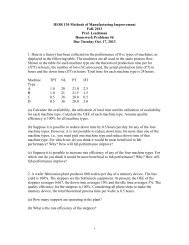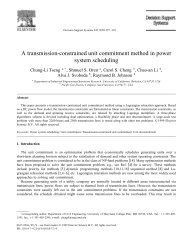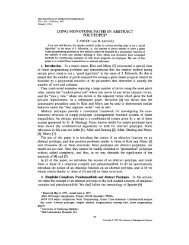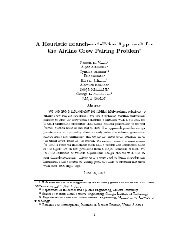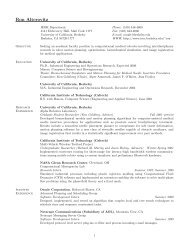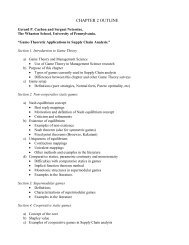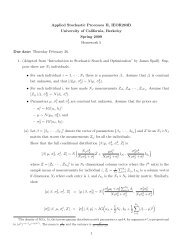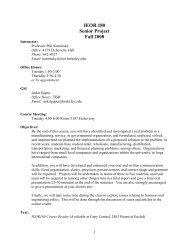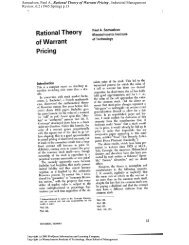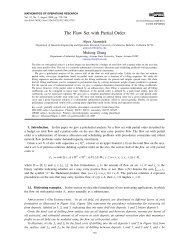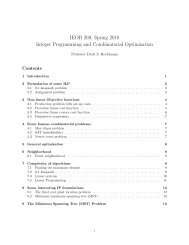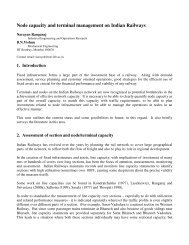a strongly polynomial algorithm for a special class of linear programs
a strongly polynomial algorithm for a special class of linear programs
a strongly polynomial algorithm for a special class of linear programs
You also want an ePaper? Increase the reach of your titles
YUMPU automatically turns print PDFs into web optimized ePapers that Google loves.
A StronglyPolynomialAlgorithm ForLPs / 957<br />
node 0. A path <strong>of</strong> length K from node i to node]j is a<br />
sequence <strong>of</strong> adjacent edges <strong>of</strong> the <strong>for</strong>m {{i, hil,<br />
{hi, h2l, . . ., I hK- II A}.<br />
Shostak (1981) describes a methodology by which<br />
the graph structure may be used to obtain a feasible<br />
solution to D (i.e., where the inequalities are <strong>of</strong><br />
the <strong>for</strong>m, ayj + byi < c). Suppose that the system<br />
contains the pair <strong>of</strong> constraints, aiyi + ajyj < cl and<br />
bkyk - bjYj < c2, where both aj and bj are strictly<br />
positive. A nonnegative <strong>linear</strong> combination <strong>of</strong> these<br />
constraints impliesAthe (redundant) constraint,<br />
(bjai) yi + (ajbk) Yk < (bjcI + ajc2),<br />
which also involves no more than two variables.<br />
(Either <strong>of</strong> ai or bk may be 0.)<br />
Generating a new constraint by combining a pair <strong>of</strong><br />
constraints in this way is called per<strong>for</strong>ming an admissible<br />
aggregation. Notice that the admissible aggregation<br />
above involves a pair <strong>of</strong> constraints which<br />
corresponds to adjacent edges, {i, jI and {j, k , in the<br />
graph representing A. We define an admissible path<br />
to be a sequence <strong>of</strong> admissible aggregations <strong>of</strong> a set <strong>of</strong><br />
constraints which corresponds to a path in the graph.<br />
(It should be made clear that not every adjacent pair<br />
<strong>of</strong> edges in the graph corresponds to an admissible<br />
aggregation because the signs <strong>of</strong> the coefficients<br />
involved must be appropriate.)<br />
Combining constraints along an admissible path<br />
from node i to node j determines a constraint involving<br />
only variables yi and yj. Thus, an admissible path<br />
from node i to node 0 or from node i to itself determines<br />
a constraint involving only yi, revealing either<br />
an implicit upper bound or an implicit lower bound<br />
to the variable yj.<br />
We define y3ax and y"'i to be, respectively, the<br />
tightest upper bound and lower bound to yk obtainable<br />
from admissible paths in the graph. If no such upper<br />
(lower) bound exists, then y'ax (ykinl) is set to infinity<br />
(negative infinity).<br />
From an adaptation <strong>of</strong> a theorem by Shostak (1981)<br />
we find the following proposition.<br />
Proposition 3. The system A Ty < c is feasible if and<br />
only ifymax > y in <strong>for</strong> all i. Furthermore, if the system<br />
is feasible, then ymax and yi"' are, respectively, the<br />
largest and smallest values y, can take in any feasible<br />
solution to the system.<br />
Aspvall and Shiloach (1980) present an <strong>algorithm</strong><br />
which finds ykax and ykfi <strong>for</strong> all k in O(m3n L) time.<br />
The authors also describe a routine which finds a<br />
feasible solution to the system within the same time<br />
bound. Megiddo (1983) uses a technique, which we<br />
call "parameterized searching," to improve the running<br />
time bound on the <strong>algorithm</strong> to O(m3n log n)<br />
time (i.e., <strong>strongly</strong> <strong>polynomial</strong> time).<br />
1.4. The (Generalized) Transshipment Problem<br />
Let G = IN, El be a directed graph with node<br />
set, N = 1O, 1, . . ., m 1, and edge set,<br />
E= {ek= (i, j) Ik l.n 1.<br />
The "flow" into edge ek = (i, j) is defined to be a<br />
number assigned to the edge, which represents the<br />
amount <strong>of</strong> some commodity sent from node i to node<br />
j. Associated with each edge is a positive "flow multiplier,"<br />
dk. If the flow assigned to ek is xk, then dkxk<br />
units are received at node j.<br />
The vector b E R'm represents the total demand <strong>for</strong><br />
the commodity at each <strong>of</strong> nodes 1 . . . m (the negative<br />
demand at node i corresponds to a "supply" that must<br />
be depleted). The quantity Ck represents the cost<br />
incurred <strong>for</strong> each unit <strong>of</strong> flow assigned to edge ek. The<br />
generalized transshipment problem, (GTP) is defined<br />
to be the task <strong>of</strong> finding an assignment <strong>of</strong> flow to the<br />
edges which satisfies the demand at nodes 1 ... m at<br />
minimum total cost. The ordinary transshipment<br />
problem (TP) is the <strong>special</strong> case <strong>of</strong> GTP where each<br />
<strong>of</strong> the flow multipliers is unity.<br />
A commonly used LP <strong>for</strong>mulation <strong>for</strong> the GTP is<br />
as follows.<br />
Problem GTP<br />
n<br />
Minimize E CkXk<br />
k=1<br />
subject to E dkxk - Xk = b<br />
k:ek= *,j)<br />
k: ek (j,*)<br />
Xk > 0<br />
which has, as its dual:<br />
Problem DGTP<br />
Maximize<br />
m<br />
biyi<br />
j= 1 .m<br />
subjectto yj-yi




